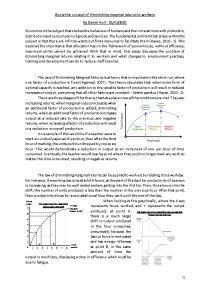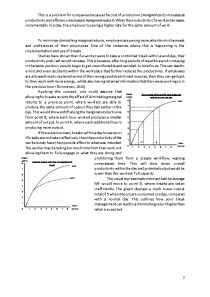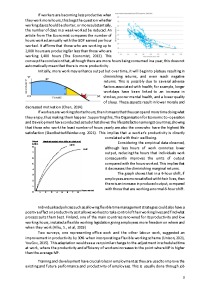Diminishing Marginal Returns - Workers



Apply the concept of diminishing marginal returns to workers. Bibliography.
Economics is the subject that studies the behaviour of humans and their interactions with production, distribution and consumption of goods and services. The fundamental problem that arises within this subject is that there are infinite wants but finite resources to facilitate them (Hayes, 2020 - 1). This bestows the importance that allocation has on the framework of economics as, without efficiency, maximum utility cannot be achieved. With that in mind, this essay discusses the problem of diminishing marginal returns relating it to workers and what changes to employment practices, training and development can do to reduce inefficiencies.
The Law of Diminishing Marginal Returns is a theory that is important in the short run, where one factor of production is fixed (Agarwal, 2017). The theory stipulates that when some form of optimal capacity is reached, any addition to the variable factor of production will result in reduced increases in output, presuming that all other factors are constant - Ceteris paribus (Hayes, 2020 - 2).
There are three stages of this theory that take place once all the conditions are met. They are: increasing returns, when marginal output increases when an additional factor of production is added; diminishing returns, when an additional factor of production increases output at a reduced rate to the previous; and negative returns, when increasing a factor of production will result in a reduction in overall production.
An example of this would be if a teacher were to mark six units of paperwork per hour, then after the third hour of marking, the units per hour dropped by one every hour. This would demonstrate a reduction in output at an increment of one per hour of time consumed. Eventually, the teacher would reach a point where they could no longer mark any work no matter the time consumed, resulting in negative returns.
The law of diminishing marginal returns can be applied to workers by relating it to a workday. For instance, if a working day consisted of 8 hours, at the start of the day the productivity of a person is increasing, as they may be well rested and are getting into the rhythm. Then, three hours into the shift, the number of units produced is less than the number in the previous hour. After that point, their productivity slows for every additional hour they work until the end of the day.
When looking at this graphically, where the X axis represents hours worked, and Y represents the output produced, at point A, there is a much larger shift in output produced in the hour consumed, presumably because the labour force is motivated and has energy. Whereas at point B, in the same amount of time the output is much less, displaying a drop in efficiency which could be due to fatigue.
- Economy & Finance Analysis
- Microsoft Word 725 KB
- 2021 m.
- English
- 6 pages (2138 words)
- University
- Dan

















